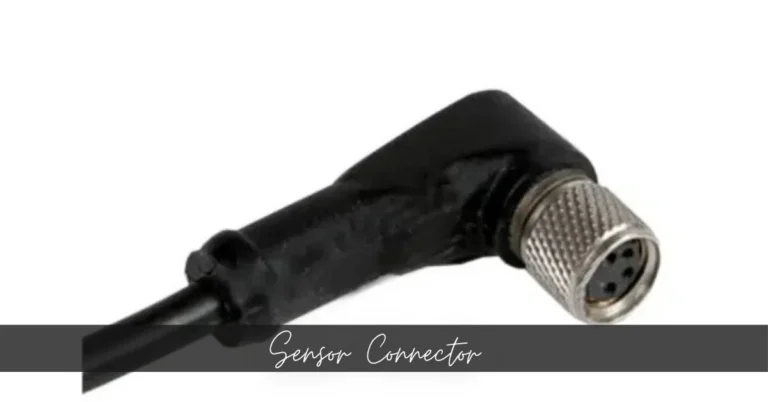In the fast-paced world of automation, precision and reliability are key. One often-overlooked component that plays a pivotal role in achieving these qualities is the sensor connector. These small but mighty devices serve as the vital link between sensors and control systems, ensuring seamless communication and data transfer. Choosing the right sensor connector can make all the difference in your automation project’s success.
Whether you’re working on industrial machinery, robotics, or smart home technology, understanding how to select an appropriate sensor connector is crucial. With various types available on the market today, making informed decisions becomes essential for efficiency and performance. Let’s explore what makes these connectors so important and how to navigate this critical aspect of your automation journey effectively.
The Importance of Sensor Connectors in Automation
Sensor connectors are the unsung heroes of automation systems. They ensure that sensors communicate with control units, enabling accurate data collection and processing.
These connectors serve as the backbone of any automated setup. Without them, sensors would fail to relay crucial information, leading to inefficiencies or even system breakdowns.
Reliability is another essential aspect. High-quality sensor connectors minimize signal loss and enhance performance in demanding environments. This reliability translates into consistent operation, which is vital for tasks ranging from manufacturing to environmental monitoring.
Durability also plays a significant role. Many automation applications involve exposure to harsh conditions like temperature fluctuations and moisture. The right sensor connector can withstand these challenges while maintaining its integrity over time.
Their importance can’t be overstated; they form the critical link that keeps everything running smoothly in an automated world.
Types of Sensor Connectors
Sensor connectors come in various types, each designed for specific applications. The choice of connector can significantly impact the performance and reliability of your automation system.
Circular connectors are a popular option. They offer robust connections and are often used in industrial environments where durability is essential.
D-subminiature connectors also have a strong presence. These rectangular-shaped options provide reliable data transmission and are commonly utilized in computer-related applications.
For more specialized needs, consider M12 connectors. Known for their compact design, they excel in tight spaces while offering excellent resistance to vibrations and environmental factors.
Another category includes modular connectors that allow flexibility by accommodating different pin configurations. This feature makes them ideal for systems that may require future adjustments or upgrades.
Each type has its benefits; understanding these can guide you toward making an informed decision based on your project’s requirements.
Factors to Consider When Choosing a Sensor Connector
When selecting a sensor connector, compatibility is vital. Ensure the connector matches your sensor’s specifications and operational requirements.
Consider environmental factors too. Temperature ranges, humidity levels, and exposure to chemicals can influence performance. Choose connectors designed to withstand these conditions for long-lasting reliability.
The size of the connector matters as well. A compact design may be essential in tight spaces but ensure it doesn’t compromise functionality.
Connector types vary widely—look at options such as circular, rectangular, or custom configurations based on your application needs.
Durability should not be overlooked. Select materials that resist wear and tear over time while maintaining connection integrity under stress or movement.
Pay attention to ease of installation. Some designs facilitate quick connections without specialized tools, saving you valuable time during setup or maintenance tasks.
Top Brands and Products for Sensor Connectors
When it comes to sensor connectors, several brands stand out for their innovation and reliability.
Molex is a well-regarded name in the industry. They offer a wide range of connectors designed for various applications, ensuring durability and performance.
TE Connectivity also deserves mention. Their sensor connection solutions are built to withstand harsh environments while providing excellent signal integrity.
Phoenix Contact specializes in industrial connectivity products. Their offerings include compact designs that save space without compromising on quality.
For those seeking versatility, Amphenol provides an extensive lineup of connector systems suitable for different sensors across multiple industries.
Binder focuses on miniature connectors that are perfect for tight spaces yet robust enough to handle demanding conditions.
These brands not only deliver high-quality products but also contribute significantly to the advancement of automation technology through continuous innovation.
Common Challenges and Solutions for Sensor Connector Usage
Sensor connectors play a vital role in automation, but they come with their own set of challenges. A common issue is environmental interference. Moisture, dust, and extreme temperatures can affect connector performance.
To tackle this problem, opt for connectors rated for harsh conditions. Look for IP-rated options that provide adequate protection against the elements.
Another challenge is compatibility between sensors and connectors. Mismatched types can lead to poor connectivity or even equipment damage. Always check specifications before purchasing any connector.
Wiring errors during installation are also frequent culprits behind malfunctioning systems. To prevent mistakes, consider color-coded wiring or clear labeling to simplify the process.
Regular maintenance is often overlooked but crucial for longevity. Schedule routine inspections and cleanings to ensure optimal functionality over time.
How to Properly Install and Maintain Your Sensor Connector
Proper installation of your sensor connector is essential for optimal performance. Begin by ensuring that both the connector and sensor are clean. Dust or debris can lead to poor connectivity.
Next, check the alignment before connecting them. Misalignment might cause damage or malfunction over time. Gently push the connector into place without forcing it.
After installation, regular maintenance is key. Inspect connections periodically for wear or corrosion. This will help identify potential issues early on.
Cleaning should be done carefully; use appropriate solvents recommended by manufacturers to avoid damaging components. Also, keep cables organized and secured to prevent strain at connection points.
Always refer to manufacturer guidelines during installation and upkeep. These instructions provide valuable insights tailored specifically for your sensor connectors.
Conclusion: Why Choosing the Right Sensor Connector is Crucial for Successful Automation
Choosing the right sensor connector is vital for achieving effective automation. A well-selected connector ensures reliable communication between sensors and control systems, minimizing downtime and enhancing overall efficiency. The impact of a quality sensor connector extends beyond performance; it influences system longevity and reduces maintenance costs.
With various types available, understanding your specific application needs is essential. Factors such as environmental conditions, signal integrity, and ease of installation play significant roles in this decision-making process. By considering these aspects alongside reputable brands and products, you can better navigate the market.
Challenges may arise during implementation or usage, but most have practical solutions that make troubleshooting manageable. Proper installation techniques also contribute to seamless operation over time.
Investing time in selecting the appropriate sensor connector pays off significantly in the long run. When everything connects smoothly within an automated system, success follows naturally.
FAQs
Q: Why is selecting the right sensor connector important?
Ans: The right sensor connector ensures reliable data transfer, enhances system durability, and minimizes downtime in automation systems.
Q: What factors should be considered when choosing a sensor connector?
Ans: Consider compatibility, environmental conditions, durability, data transfer speed, and application-specific requirements.
Q: Are there different types of sensor connectors for various applications?
Ans: Yes, sensor connectors come in various types, such as circular, rectangular, and custom designs, tailored to specific industrial needs.
Q: How does a sensor connector impact system performance?
Ans: A high-quality sensor connector improves reliability, reduces wear and tear, and supports consistent functionality over time.
Q: Can the wrong sensor connector lead to system failures?
Ans: Yes, using an incompatible connector can cause data loss, increased downtime, and reduced system efficiency.

